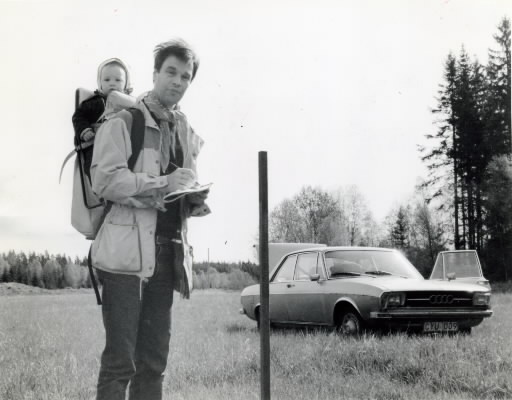5. Scientists Battle against Radioactive Contamination
Jan. 29, 2013
Chapter 2: Soviet Union
Part 3: The Spread of Nuclear Contamination over Sweden
Part 3: The Spread of Nuclear Contamination over Sweden
Sweden's scientific community is also putting a great deal of energy into the fight against radioactive contamination. We joined one of the researchers as he went on a survey of pastures, one of many studies being carried out with the aim of bringing contaminated land back into production.
Klas Rösen, a researcher in the Department of Radioecology at the Swedish University of Agricultural Sciences, drove us out twenty-five miles east of Uppsala.
"Look over there!" he exclaimed, pointing to a field. "The length of the grass changes every five meters, according to the amount of potassium added to the soil."
Rösen started experimenting with potassium a year after the accident at Chernobyl. Cesium and potassium are similar in composition, but, as plants absorb potassium first, a large amount of potassium in the soil reduces the amount of cesium absorbed by the stock which graze on the grass.
The first results were encouraging, so the practice of mixing contaminated soil with potassium has become widespread. Naturally, one of the reasons for the technique's unusually rapid adoption on farms has been the government's desire to reduce the cesium concentration in humans to as low a level as possible.
As befitting a country which is situated on the doorstep of one of the nuclear superpowers, Sweden has, since 1950, had a system in place to monitor and give warning of radioactive contamination and has also carefully worked out what countermeasures should be taken in the event of a nuclear war. The monitoring system has successfully detected evidence of Soviet nuclear testing several times, and in 1986, its reliability was once again demonstrated: Sweden was the first foreign country to detect that there had been an accident at Chernobyl.
Sweden's decision to dismantle all nuclear power stations in the country by the year 2010 may be seen as the culmination of these policies. Based on a referendum conducted in 1980, the year after the accident at Three Mile Island, the Swedish government resolved to phase out all twelve reactors currently in operation within the next thirty years.
"The Chernobyl disaster confirmed the wisdom of this decision," Rösen said. "But," he added, "it also showed us that we hadn't taken enough precautions to prevent our country from becoming contaminated by radioactive fallout."
The cesium contamination caused by Chernobyl was between ten and forty times greater than that caused by the atmospheric testing carried out at the beginning of the 1960s by the United States and the Soviet Union. The effect on agricultural produce, livestock, and wild animals was, therefore, much greater than the Swedish government had ever bargained for.
"In short," Rösen said with a note of irritation in his voice, "we just don't have the technology to cope."
The Department of Radioecology, where Rösen works, hurriedly increased the number of staff from fifteen to thirty after the accident, and concentrated their energies on finding practical methods of combating the contamination. One result of their research has been the discovery that cesium in grass tends to concentrate near the roots; consequently, they have advised farmers not to cut their grass right down. The discovery of the potassium treatment was another of the department's successes.
Rösen, who is responsible for a major proportion of the research, is proud of the department's success in conducting research that has received worldwide recognition. However, he realizes that there is still a long way to go.
"Our research has been concentrated on the agricultural sector. We have been unable to do anything about the forests and lakes. And, in addition to the problem of cesium, we're faced with acid rain and the destruction of the ozone layer—problems for which we simply don't have any solutions."








